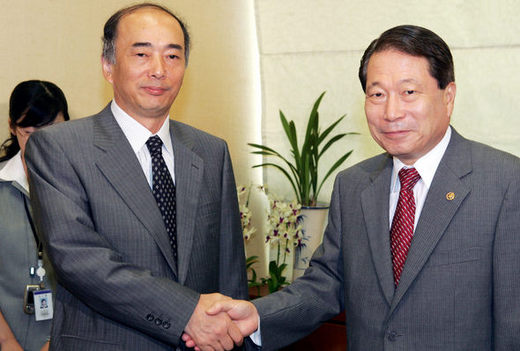 |
|
Korea's Vice Foreign Minister Yu Myung-hwan (right) and Kenichiro Sasae, head of Japanese Foreign Ministry's Asia-Oceania bureau, shake hands at Yu's office in Soeul on August 24.
|
Could spell change in Japan-S.K. cooperation, relations
Kenichiro Sasae, head of the Japanese Foreign Ministry’s Asia-Oceania bureau, recently visited Seoul. Though little is known regarding the exact nature of his visit, it came at a sensitive moment. A source said that Sasae and his South Korean counterparts talked about issues of mutual concern, but the source did not specify what was discussed. Sasae reportedly met with South Korea’s Vice Foreign Minister Yu Myung-hwan and chief nuclear envoy Chun Young-woo during his stay here. Considering Sasae is Japan’s envoy to the six-party talks on North Korea’s nuclear program, the encounter with Chun can be seen as a regular discussion session, though Seoul has not recognized Tokyo as its consulting partner in the multilateral discussion, especially after Japan began taking a hard-line stance in dealing with North Korea. The six-party talks aimed at dismantling the North’s nuclear weapons program, involving the two Koreas, Japan, the U.S., Russia, and China, have been in a stalemate since November. Of course, it is too early to see the one-on-one meeting with Chun as a sign of possible change in Japan’s North Korea policies. Still, considering Tokyo is seeking a summit with South Korea in November on the sidelines of the Association of South East Asian Nations, Plus Three (ASEAN+3) meeting, it is appropriate to say that the visit could be part of the nation’s attempt to pave the way for its North Korea policy direction after the era of Prime Minister Junichiro Koizumi.Also, Sasae’s meeting with Vice Minister Yu is not just a courtesy call. He might have conveyed his government’s stances over an array of controversial issues between the two countries, such as Prime Minister Koizumi’s recent visit to the controversial Yasukuni Shrine, where several Japanese soldiers deemed war criminals are honored; disputes over Dokdo, a series of islets claimed by both nations, and the alleged distortion of Japan’s imperial history in school classes. Sasae’s meeting on the previous day with his South Korean counterpart Lee Hyuk would not have been enough contact to start resolving such sticky issues. A multilateral summit would be the first step for Japan to break the impasse in its relations with South Korea. Sasae might have relayed a message to his superiors touching on a possible summit. During the meeting, Vice Minster Yu reportedly urged Japan to hold a correct perception of history regarding its prime minister’s repeated visits to Yasukuni Shrine and its territorial claims over the Dokdo islets if it intends to normalize strained bilateral relations. Sources said that Yu and Sasae held in-depth discussions, especially on the issue of the islets. Meanwhile, South Korea’s Foreign Minster Ban Ki-moon said in an earlier meeting that President Roh Moo-hyun will visit China in mid-October to discuss with his counterparts a wide range of issues, including North Korea and bilateral economic cooperation. In a related move, President Roh’s chief security advisor, Song Min-soon, who is on a tour of China, will return home on Friday after completing his talks with Chinese officials on the same issues. "Roh’s visit to China has been in the works for a long time and he was supposed to go there in August," a government official said. "But the president’s visit is not something that can be prepared abruptly."






